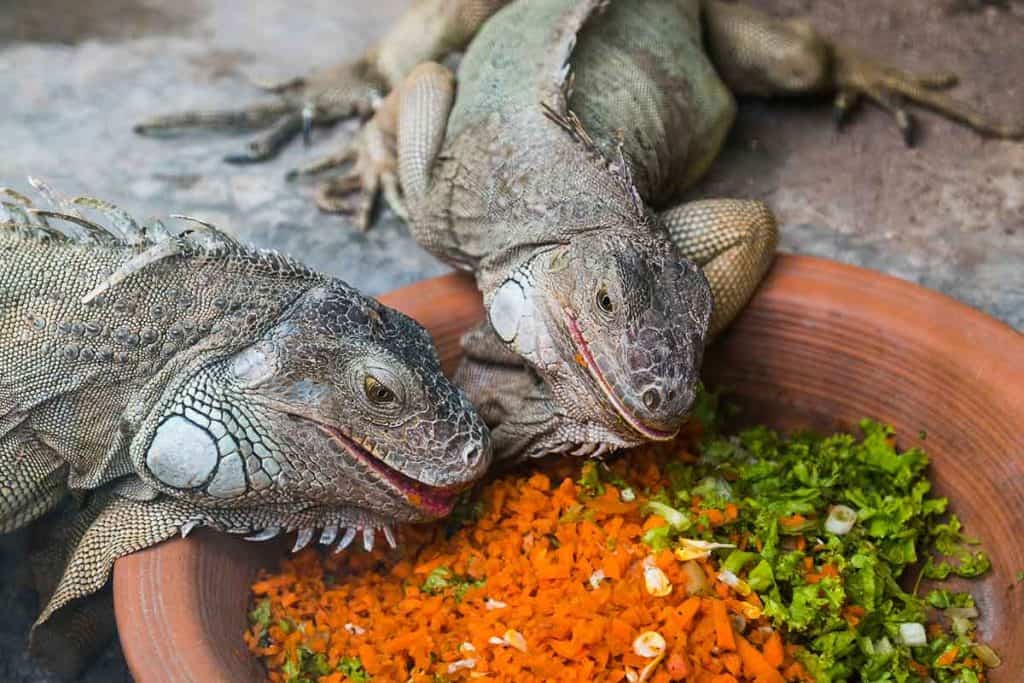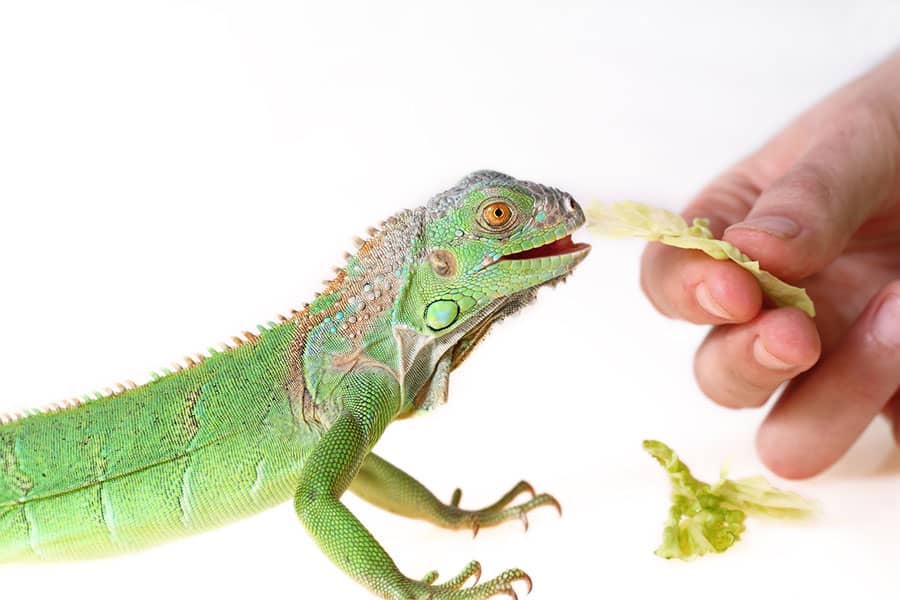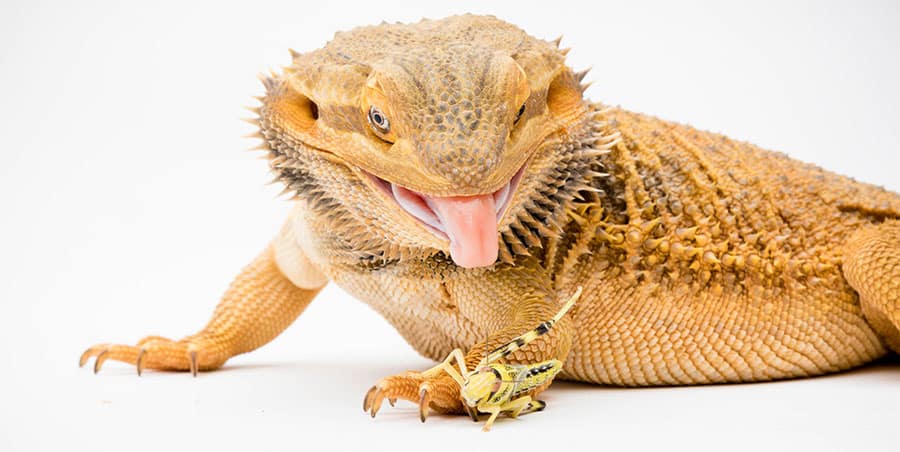Whether you’re raising a new pet or trying to befriend a common lizard in your yard, one of the first things you ought to know about is what lizards eat. They all look pretty similar in terms of body structure and general appearance, but are their diets at all similar?
Different lizard species would have different diets, and the earth has a boatload of them! Some lizards like Nile monitors are carnivores, others like chameleons are insectivores, others such as bearded dragons are omnivores, and a few select lizards are strict herbivores!
Each lizard has a specially adapted digestive system that is designed to process their specific diet, and if they are fed the wrong diet, they can suffer from malnutrition, a blocked digestive tract, and even death.
It is important to know what you can and should not feed lizards in these different groups to ensure they get the best nutrition possible whether they are your pet or the lizards you see running around your garden!
Herbivorous Lizards’ Diets
Herbivorous lizards only eat plant matter. If the odd bug makes its way into their mouths while they’re grazing, it is not the end of the world. However, they should never intentionally be fed insects, and they will not seek them out in the wild.
Some examples of these uniquely vegetarian lizards include:
- Green iguana
- Fiji-banded iguana
- Black spiny-tailed iguana
- Rhinoceros iguana
- Uromastyx
- Chuckwalla
Greens
An herbivore’s diet is made up of a variety of different greens and vegetables that all have different nutritional values and benefits. Some of the most nutritious and delicious greens to include in an herbivorous lizard’s diet are:
- Mustard greens
- Dandelion greens
- Collard greens
- Beet tops
- Endive
- Escarole
- Dark lettuces
- Watercress
- Turnip and parsnip tops
These greens should be low in phosphorus, and high in
Generally, darker greens are best, since they are more flavorful and contain more vitamins and
Other Vegetables
In addition to dark, leafy greens, your herbivorous lizard should also be fed a variety of vegetables to add in lots of unique colors, textures, and tastes to keep them from getting bored and suffering from nutritional deficiencies.
Good vegetables to include in your herbivorous lizard’s diet include:
- Red, yellow, and green bell peppers
- Sweet potatoes
- Carrots
- Pumpkin
- Butternut squash
- Orange and yellow squash
- Zucchini
- Turnips and parsnips
Fruit
As a treat, you could also add a small amount of fruit to your herbivorous lizard’s meal once a week as a tasty, sugary incentive and enrichment tool. Only 5% to 10% of your lizard’s total diet should be made up of fruit to prevent mouth rot and obesity.
Always offer some more fibrous food after fruit has been eaten to help your lizard clean out any leftover soft fruit from between their teeth. Again, if fruit is left between the teeth for a long time, it can start to ferment and rot, which will lead to tooth decay and gum disease.
Good fruits to use as treats include:
- Banana
- Apple
- Pear
- Blueberries
- Blackberries
- Raspberries
- Mulberries
- Sweet melon
- Watermelon
Herbs and Flowers
To add even more flavor and increase your lizard’s love for their food, you can also add some flowers and herbs to their daily meals! Flowers and herbs do not add much nutritionally; however, they are very tasty.
Good herbs and flowers to include are:
- Basil
- Thyme
- Lavender buds
- Rose petals
- Hibiscus flowers
- Zucchini blossoms
- Mint
Make sure any herbs and flowers you offer to your lizards are of edible grade and not solely meant to be used in fragrances, soaps, or in oils, as they may include preservatives or chemicals that will make your lizard sick.
Insectivorous Lizards’ Diets
Most lizards fall into the insectivore category. Most of the garden lizards you see in your backyard will be strict insectivores and will likely even help you with pest control! Many lizards you may see roaming around your home looking for mosquitoes and spiders are also mostly insectivores.
Other strictly insectivorous lizards include:
- Leopard geckos
- Chameleons
- Green anoles
- Brown anoles
- African fat-tailed geckos
- Fence lizards
- Skinks
Insectivorous lizards need to be fed a diet of insects that are high in protein and low in fat. Their prey items also need to be appropriately sized to prevent choking and digestive impaction. For example, baby geckos need to be fed small prey items such as pinhead crickets, while larger green anoles can be fed locusts!
Ideal Feeder Insects
Variety is key when feeding insectivorous lizards. A steady diet of only crickets, for instance, can become very monotonous and boring to lizards, which can result in them becoming so bored and uninterested in food that they stop eating entirely!
Key insects to include in your insectivorous lizard’s diet include:
- Crickets
- Dubia roaches
- Phoenix worms (also known as black soldier fly larvae)
- Hornworms (also known as Goliath worms)
- Earthworms
- Nightcrawlers (very large earthworms)
- Mealworms
- Superworms
- Silkworms
- Waxworms (high in fat; only use as treat items)
- Butterworms (high in fat; only use as treat items)
A varied diet of worms and insects will help your lizard will get a nutritionally balanced diet as well as a tasty and interesting one!
Finally, it is important to feed your lizards appropriately-sized insects. Any feeder insects should be no larger than the space between your lizard’s eyes. If they are too large, they pose a choking hazard as well as posing an impaction risk.
Gut-Loading Insects
Insectivores still need all the nutrients that come from plant matter. However, they get these nutrients through the insects that they eat. This means the insects your lizard eats need to have eaten a healthy meal just before they are fed to your lizard.
Feeding your insects before offering them to your lizard is called gut loading. In the 12 to 24 hours before you feed the insects to the lizard, they need to eat a high
Essentially, as the insects digest the plant matter, they pass on any vital vitamins and minerals to the lizard!
Carnivorous Lizards’ Diets
Carnivorous lizards only eat animal protein in the form of meat and eggs, though some smaller varieties will also eat insects.
Truly carnivorous lizards are usually very large, such as monitors, tegus, and komodo dragons! These lizards actively hunt their prey instead of using the “sit-and-wait” method that other insectivorous or omnivorous lizards use.
Carnivorous lizards should be fed a varied diet of appropriate feeder animals in captivity. Even though it is technically all meat, they should still be offered variety, as they can still become bored and completely uninterested in their food.
Prey Items
Appropriate prey items for carnivorous lizards include:
- Large hornworms
- Large nightcrawlers
- Mice (mice pinkies are appropriate for baby carnivores)
- Rats (rat fuzzies are appropriate for slightly larger baby carnivores)
- Hamsters
- Rabbits
- Quail and chicken eggs (with the shells)
- Quails
- Chickens
- Smaller lizards
- Feeder frogs
- Feeder fish (never goldfish)
- Chunks of beef (with minimal fat)
- Ostrich knees (or other cartilaginous joints as treats to chew on)
It is important to choose lean animals to feed your lizards as too much fat in their food will lead to obesity. Obesity in lizards is very dangerous, as their organs suffer greatly, and it can lead to death.
The size of the prey item should be proportional to the size of the animal. For example, Ackie monitors should be fed smaller rodents, whereas tegus and much larger nile monitors can be fed full chickens and rabbits.
Komodo dragons can even take down buffalo and antelope in the wild and manage to chow down on those over a number of weeks!
Live Prey vs. Frozen/Thawed Prey
Many reptile owners wonder whether live prey or frozen/thawed prey is the better choice for their pets. Feeding live prey to your lizard in captivity poses a huge risk to their health.
Live prey contains parasites and bacteria that is easily passed on to your lizard. The process of freezing prey actually kills off these parasites and makes the prey item safer for your lizard!
Live prey can also fight back and cause your lizard unnecessary harm and stress. Even the timid mouse can become mighty feisty when confronted with a mouthful of teeth! This makes frozen/thawed prey the best option as far as safety, longevity, and efficiency.
On feeding day, take out the required amount of prey for your lizard and place it in a hot bowl of water. Wait until the prey item is completely defrosted and slightly warmer than room temperature. Then you can feed it to your lizard warm and wet!
Omnivorous Lizards’ Diets
Omnivores eat a variety of plants as well as insects. All of the above greens, vegetables, fruits, herbs, and flowers are suitable for all omnivorous lizards.
These lizards usually eat more protein as babies and juveniles and gradually switch to eating more plant matter as adults. This is because they need the significant amount of energy insect protein provides in order to develop their growing bodies.
Common omnivorous lizards include bearded dragons, blue tongue skinks, agamas, and crested geckos.
For most omnivorous lizards, the ideal ratio of insect protein to plant matter is usually recommended as:
- 70% insect protein : 30% plant matter for babies and juveniles
- 30% insect protein : 70% plant matter for adults
It is important to stick to these ratios because lizards require different amounts of nutrition depending on their age, and they can get sick if they do not receive the correct nutrition.
Read on to find out what insects you can include in their diet!
What Should Lizards Never Eat?
Some food items should never be fed to lizards regardless of their specific diet because they are either toxic or they are devoid of nutritional benefits. Here’s what you should avoid:
- Citrus fruits are highly acidic and can burn the digestive systems of reptiles and other animals
- Avocado is highly toxic to lizards
- Onion, garlic, and chives are highly toxic to lizards
- Tomatoes are too acidic for lizards
- “Human food” like bread, chocolate, and processed meats all contain chemicals that are harmful to reptiles
- Cooked meat is nutritionally devoid and can be harmful to reptiles
- Watery lettuces, cucumbers, and celery are all water and fiber and do not have many nutrients to them (and will cause runny poops)!
FAQs on Feeding Lizards
Can I feed the lizards in my garden or house?
Feeding the lizards in your garden and house is an amazing experience similar to feeding the birds in your garden!
You get to put out food and watch the different species come in for a quick bite. Doing this regularly can actually increase the biodiversity in your garden and help you control pests like aphids, slugs, and small caterpillars that would otherwise ravage your veggie patches and beautiful flowers.
Put out a variety of prey items in a shady spot where the lizards will feel secure and not at threat of predators such as cats and birds.
Sit quietly and watch; it may take a while for the lizards to show up, but they will eventually! See which prey items they enjoy and which they leave behind. If you have agamas in your area, you can also put out some greens and vegetables, because most agama lizards are omnivores!
Do all lizards need supplements?
All lizards need an additional
You can add other vitamin supplements to their food to provide them with general nutritional support. If you offer your lizard a prepackaged meal, then they usually come with additional vitamins included.
If you are feeding the lizards in your garden, you can add some supplements to the food you put out for them so they can be as healthy as possible.
Scurrying Off…
Figuring out what lizards eat will depend on what species of lizard they are. Their species will determine what general diet group they belong to, such as herbivores, omnivores, insectivores, or carnivores!
Each diet group has different nutritional requirements that need to be met by you, the owner. Herbivores need to be fed exclusively on plant matter, omnivores need to be fed a balanced mixture of plant matter and insect protein, insectivores need to be fed exclusively insects, and carnivores need to be fed animal protein.
It is important to also supplement your lizard’s meal with additional




